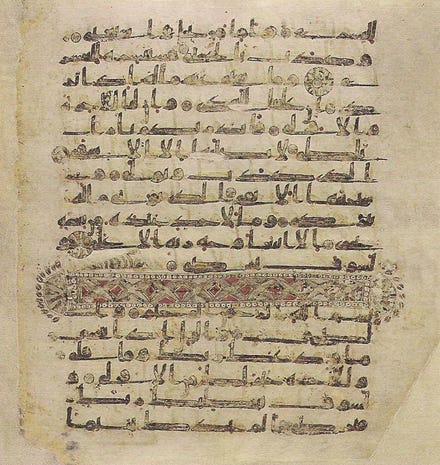Do the Earliest Qur'anic Manuscripts Validate Muslim History?
Searching for a Fixed Point in Confirming Islamic Historical Accounts
According to later Muslim tradition, the third Caliph (Uthman, reigned 644-656 CE) settled the text of the Qur'an between the years 650-656 CE. He did this by getting rid of all variant readings and nominating a supposedly accurate and definitive text. So, if we can point to a manuscript that can be accurately dated to this period, it would do much to anchor the history of early of Islam to something tangible.
Muslim scholars justify their belief in the reliability of the Uthmanic tradition (and therefore a very early codification of the Qur’anic text) by pointing to a series of texts believed to be very ancient manuscripts (known as ‘Mushafs’ in Arabic), which are supposedly copies of the Uthmanic text.
In fact, it is even claimed that one such manuscript (the Topkapi manuscript, pictured above) was Caliph Uthman’s personal copy of the Qur’an. This certainly seems very promising from a Muslim perspective.
If these manuscripts can indeed be shown to date from the mid 600’s CE and if they correlate with each other, it will definitively point to an ancient ‘mother text’ upon which they are all based. It would also do much to validate the rest of Muslim history as it will provide us with tangible links to the earliest years of Islam. Much will therefore depend on the question of the authenticity of the Uthmanic Mushafs.
It should in light of the above not be surprising to find that the so-called Uthmanic Mushafs have been subjected to intense scholarly scrutiny over the years. In fact, many devout Muslim scholars have worked on these texts, eager for the chance to firmly authenticate part of the Islamic tradition. It turns out, however, that the overwhelming consensus of the academics who analyzed these texts is that none of them can remotely be described as dating from the time of Uthman.
As mentioned, the most famous of the so-called Uthmanic manuscripts is the Topkapi Manuscript (so called because it is housed in the former Topkapi Palace, former residence of the Ottoman Sultan in Istanbul).
It is almost an article of faith for many devout Muslims that this manuscript used to be the personal Qur’an of the Caliph Uthman. This idea is, however, dismissed out of hand by two high-profile Turkish scholars who spent years studying some of the oldest Qur’an manuscripts in existence. This is their verdict on the Topkapi Manuscript:
Prof Ekmeleddian Ishangolu: “Judging from its illumination, the Topkapi Mushaf dates neither from the period when the Mushafs of the Caliph Uthman were written nor from the time when copies based on those Mushafs were written.”
Dr Tayyar Altikulac: “Even though we would like to publish this sacred text as the Mushaf of Caliph Uthman, our research indicated that it was neither the private Mushaf of Caliph Uthman, nor one of the Mushafs he sent to various centers.”
Another famous manuscript about which claims are made regarding its ancient origins is the so-called Samarqand Qur’an (housed in the Hast Imam Library in Tashkent, Uzbekistan). Careful analysis of the text of this copy of the Qur’an, once again, proves that it is not nearly as ancient as is generally believed.
This is Dr Altikulac’s emphatic answer to the question as to whether this manuscript could perhaps be traced back all the way to Uthman: “[There are] six reasons why it could not be so, including almost no discipline of spelling, different ways of writing the same word, scribal mistakes, copyists’ mistakes, written by a scribe who had no writing experience, and later added signs after verses. In conclusion, we can say that the Tashkent [Sammarqand] Mushaf was neither the Mushaf, which Caliph Uthman was reading when he was martyred, nor any one of the Mushafs that he sent to various centers, nor the copy that was kept in Medina for the benefit of the people”
Many other famous manuscripts could be added to the list of supposedly ancient Qur’ans that go right back to the time of Uthman (e.g., the Istanbul Mushaf, the Cairo Al-Husayni manuscript and the Petropolitanus manuscript housed in Paris etc.) but it can be shown in every case that they had their origins long after the time of Uthman. It should come as no surprise, given the convoluted Qur’anic codification process described in the hadiths, that the supposedly ancient Mushafs so deeply revered by Muslim scholars simply add more confusion to the textual history of the Qur’an.
In summary, instead of anchoring the origins of the Qur’an squarely in the mid-7th century Arabian Desert, these manuscripts merely confirm that it is quite likely that the Qur’an is a creation of another time and place. So, the deep uncertainty about the realibility of later Muslim accounts about the earliest years of Islam remain.
As is illusrated above, there are many serious questions that should be asked about the reliability of the generally accepted accounts of Muslim history. Please see my book ‘The Mecca Mystery – Probing the Black Hole at the Heart of Muslim History’, for an in-depth exploration of some of these questions.
Kind regards,
Peter
If you received this article via email, please forward it to your friends who might be interested. Otherwise, use the button below to share it on social media.
Please use the button below to subscribe, or to support my work by upgrading to a paid subscription.




